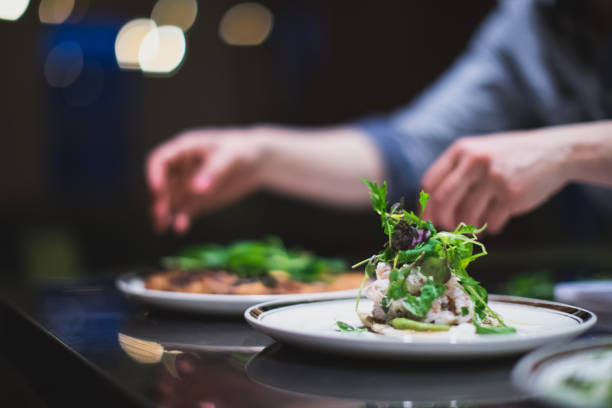Culinary Alchemy: Transforming Everyday Ingredients into Gourmet Delights
Unlock the secrets of culinary wizardry and elevate your home cooking to new heights. Discover innovative techniques and unexpected flavor pairings that will transform humble ingredients into show-stopping dishes. Get ready to impress your guests and tantalize your taste buds with these gourmet transformations.

Texture Transformations: Crispy, Creamy, Crunchy
Texture plays a crucial role in the perception of food, often being as important as flavor itself. Mastering texture transformations can turn a one-note dish into a symphony of sensations. Consider the humble potato: when mashed, it’s comforting; when crispy, it’s indulgent. But what if you could combine these textures in one dish? Try creating a silky potato puree topped with crispy potato skins for a contrast that delights the palate. Or take cauliflower, often boiled into submission. Roast it whole until golden, then blend half into a creamy sauce while keeping the rest in crispy florets. This textural interplay elevates the vegetable from a simple side to a sophisticated centerpiece. By focusing on creating contrasts within a single ingredient, you can add depth and interest to your dishes without complicating your ingredient list.
Flavor Alchemy: Unexpected Pairings
The true magic of culinary alchemy lies in unexpected flavor combinations that challenge and delight the palate. It’s about finding harmonies in contrasts and similarities in disparate ingredients. Consider pairing sweet with savory, like a watermelon and feta salad drizzled with balsamic reduction. Or explore umami-rich combinations like miso-glazed eggplant, where the fermented soybean paste brings out the vegetable’s natural meatiness. Even familiar herbs can be used in unfamiliar ways: try infusing mint into a creamy risotto or adding basil to a fruit-based dessert. The key is to start with classic flavor affinities and then push the boundaries. A touch of coffee in a beef stew or a sprinkle of lavender in shortbread cookies can transform familiar recipes into gourmet experiences. By thinking outside the traditional flavor box, you can create dishes that are both comforting and exciting.
Molecular Gastronomy at Home
While molecular gastronomy might seem intimidating, many of its techniques can be adapted for home use, allowing you to add a touch of culinary magic to your everyday cooking. Spherification, for instance, can turn simple liquids into caviar-like pearls. Try making balsamic pearls to garnish a caprese salad or mint spheres to float in a mojito. Foams, another staple of modern gastronomy, can be created with a simple hand blender and lecithin, adding airy texture to soups or sauces. Even something as basic as using sodium citrate can help you create silky smooth cheese sauces without clumping. These techniques not only add visual appeal but also introduce new textures and intensify flavors. By incorporating just a few molecular gastronomy methods into your cooking, you can transform familiar dishes into avant-garde creations that surprise and delight.
Plating Like a Pro
The final step in culinary alchemy is presentation. A well-plated dish can elevate the dining experience from satisfying to memorable. Start by thinking of your plate as a canvas. Use negative space to draw attention to the food, and consider color contrasts to make elements pop. Play with height by stacking components or using garnishes to add vertical interest. Sauces can be artfully drizzled or dotted to create visual flow. Even the shape of the plate can influence perception: round plates for curvy, organic presentations, and square plates for more structured, geometric layouts. Remember that odd numbers are more visually appealing, so plate in threes or fives. Garnishes should be purposeful, adding not just beauty but also complementary flavors or textures. By mastering these plating techniques, you can transform even the simplest meal into a restaurant-worthy presentation that delights the eyes as much as the palate.
Culinary Alchemy Tips & Facts
• Use a blowtorch to quickly caramelize sugar on desserts or add a smoky char to vegetables.
• Experiment with different types of salt to add complexity to dishes; try smoked salt on chocolate desserts.
• Infuse oils with herbs or spices to add depth to dressings and marinades.
• Dehydrate fruits and vegetables to concentrate flavors and create unique garnishes.
• Learn the art of sous vide cooking to achieve perfect textures in meats and vegetables.
• Use liquid nitrogen for instant ice creams or to create dramatic smoking effects (with proper safety precautions).
• Explore fermentation to develop complex flavors in homemade condiments and pickles.
• Incorporate edible flowers not just as garnishes but as flavor components in salads and desserts.
In the realm of culinary alchemy, the possibilities are endless. By embracing creativity, understanding scientific principles, and honing your techniques, you can transform everyday ingredients into extraordinary culinary experiences. Remember that the most important ingredient is your imagination. Experiment, take risks, and don’t be afraid to fail – that’s how culinary breakthroughs happen. As you continue to explore and push boundaries in your kitchen, you’ll not only create amazing dishes but also develop a deeper appreciation for the magic of food. So go forth, and let your kitchen be your laboratory, where ordinary becomes extraordinary, and every meal is an opportunity for delicious discovery.





